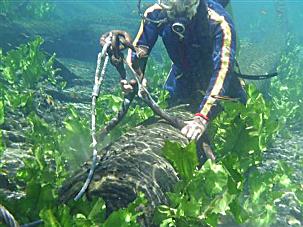What can you tell me about sinker' cypress versus regular cypress?
A. Normally, logs from cypress trees will float in water when they are harvested. Sometimes, however, they have a bacterial infection in the living tree that increases the water content so that the freshly harvested logs will not float; such logs are called “sinkers.” Sinker logs do not usually come from younger trees, but would be from larger, older trees.
So, a century or more ago, when we were harvesting the large trees from virgin cypress forests, occasionally the butt log would be bacterially infected and would not float. Oftentimes, these valuable butt logs were treated carefully so that they did not sink to the bottom of the lake or river. (Sinker logs were the largest log from the tree and contained highly valuable lumber; if they sank to the lake or river bottom, it was a lost profit.)
|
KNOWLEDGE CENTER
Gene Wengert, aka The Wood Doctor, troubleshoots wood related problems, and explores lumber and veneer qualities and performance, species by species, in Wood Explorer, inside FDMC's Knowledge Center.
|

|
However, as wood was plentiful and not too expensive, some logs were lost; that is, they sank. Today, we are recovering these logs that have been submerged for a century or more; the lumber they produce is called “sinker cypress.”
In my opinion the main issues or difference between the fresh cypress and sinker cypress will be in the appearance--for old growth (sinker or non-sinker), ring spacing is closer (also called tighter) and heartwood color is more dramatic plus the price is higher. Also, wood from the old growth forests has more natural resistance to decay than wood from today’s so-called second growth forests.
|
ARTICLE
Bringing Cypress back to life
The Sinker Cypress from Marwood Inc. of Jeffersonville, IN, is pre-cut timber salvaged from rivers and lakes, that has been naturally preserved for hundreds of years.
|

|
There can also be a strength issue. The bacteria (we find these bacteria in other species as well including hemlock, willow, elm, oak and cottonwood) create an odor that is not pleasant and create enzymes that weaken the wood. Although the odor is gone from century old logs, the strength loss is still there. When sinker cypress is used for decking or other items where its strength is important, we know that the wood is weaker than the published strength values due to the bacterial action of a century ago. However, I have not seen revised design values for sinker lumber. Nevertheless, it could be risky (or even dangerous) to use sinker in a structural application.
This strength loss can also result in more cracking during drying and splitting in machining compared to non-infected wood from the upper logs of old trees or logs from younger trees. With very careful processing (and possibly higher expense), the sinker wood can turn out fairly well.
On the other hand, sinker cypress does have some attraction due to its history of being on the bottom of a river or lake for a century after the log was harvested. However, I do believe that today's freshly harvested logs produce wood that is just as attractive as old growth. This new wood does not have the history, but is the customer willing to pay more for this history?







Have something to say? Share your thoughts with us in the comments below.